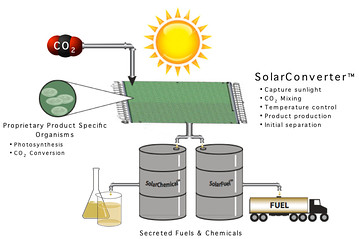forum
library
tutorial
contact

Start-Up's Biofuel Recipe
Mixes CO2, Slime and Sunshine
by Michael BurnhamNew York Times, July 27, 2009
|
the film forum library tutorial contact |

|
Start-Up's Biofuel Recipe
by Michael Burnham |
 A Massachusetts biotechnology start-up unveiled plans today to produce chemicals and transportation fuels from carbon dioxide, the main heat-trapping gas that contributes to global warming.
A Massachusetts biotechnology start-up unveiled plans today to produce chemicals and transportation fuels from carbon dioxide, the main heat-trapping gas that contributes to global warming.
Cambridge-based Joule Biotechnologies Inc. -- founded in 2007 and funded by the investment firm Flagship Ventures -- will rely on what company officials dub "Helioculture" technology to mix brackish water, nutrients and photosynthetic organisms in flat "SolarConverter" panels. Laboratory tests show that adding CO2 and sunlight to the mixture causes the organisms to secrete the chemical equivalent of ethanol and hydrocarbon-based fuels and chemicals, Joule's president and CEO, Bill Sims, said in an interview.
Sims would not divulge details of Helioculture's mystery critters.
"We believe we are the first to use these organisms to produce fuel," Sims added.
Joule plans to break ground on a modular pilot plant early next year. In 2011, the company plans to break ground on a commercial-scale operation with the capacity to produce more than 20,000 gallons of fuels per acre, per year.
Joule is evaluating sites near CO2 producers, such as coal-fired power plants and cement kilns, for the pilot plant. Sims said the list of potential locations includes Texas, Arizona, Nevada and New Mexico -- all sun-soaked states with wide-open spaces.
To build a commercial plant, Joule executives are mulling a joint venture with either a CO2 or an oil producer. Sims would not say how much it would cost to build a commercial-scale plant -- whose optimum size would range from 1,000 to 10,000 acres.
"A large project would look much like a solar array," Sims explained. "Instead of converting the sun's heat energy into electrons, we're using it to create liquid fuels."
David Berry, a partner with Flagship Ventures and co-founder of Joule, said Helioculture's advantages are that it is modular and that it does not require arable land or fresh water.
"The real goal when we built this company was to make a renewable fuel that could be scaled at billions and billions of gallons at a low cost," added Berry, who also serves on Joule's board of directors.
Capping the nation's greenhouse gas emissions, he posited, would be a boon to Joule's business plan. The company aims to produce fuel at the equivalent cost of less than $50 a barrel of oil.
The House passed climate legislation last month that would cap U.S. greenhouse gas emissions at 17 percent below 2005 levels by 2020 and 83 percent by 2050. Emissions allowances for capped sectors, such as power plants and oil refineries, would begin at the equivalent of 4.627 million metric tons of CO2 in 2012 and peak at 5.482 million metric tons in 2016, before declining to 1.035 million metric tons in 2050.
A U.S. EPA analysis of the bill (H.R. 2454 (pdf)) projects an allowance price of $13 per metric ton of CO2 equivalent in 2015 and $16 in 2020. The Senate will take up companion legislation in September.
Berry said CO2 could be a negative-cost feedstock for Joule, depending on the stringency of a U.S. emissions cap.
"The heavier the cap, the more companies have to figure out what do with their carbon," he explained. "We represent an alternative means to do something with the carbon."
learn more on topics covered in the film
see the video
read the script
learn the songs
discussion forum
